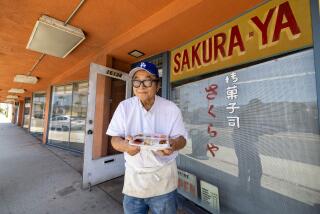Conjecturer’s Sugar
When Shinobu “Shan” Ichiyanagi immigrated to the United States from Japan in 1971, the plan was to be an international businessman, not a candy artist. But lurking in his memory like a time-release capsule was a fateful experience: As a boy in his native Sapporo, Ichiyanagi was transfixed by the traveling street artists of amezaiku, or sweet candy craft, who set up stands during the warm summer months to fashion fantastic animals and objects from seething liquid syrup. One man in particular made an indelible impression. “He was like a god,” the 51-year-old West Los Angeles resident recalls. “He made with his wrinkled old hands something really beautiful in 30 seconds to one minute.”
Years later, while Ichiyanagi was studying English at Reseda Adult School, fellow student Masaji Terasawa mentioned that he would like to show something to the class. As it happened, Terasawa was an amezaiku master who had apprenticed with some of Japan’s most renowned craftsmen. “He started demonstrating candy art,” Ichiyanagi says. “That memory came back. I went, ‘Oh, my God.’ I asked Mr. Terasawa, ‘May I learn?’ He didn’t say anything but ‘Just come.’ I went to Disneyland for a demonstration. Oh, boy, so many people gathered round. I wished I could make people happy like he did. So I started following him around,” he says.
Ichiyanagi’s early attempts at amezaiku, which he says has an approximately 300-year-old history in Japan but derives from a far older Chinese art, weren’t altogether successful. His horse looked “more like a jackass.” He burned his hands on the melted candy, which is made of rice, sugar or corn syrups and can reach temperatures of up to 200 degrees. But he kept at it. When he felt confident enough, he invited a few neighborhood kids to watch. “I told them, ‘Free candy.’ ”
That was about 30 years back. These days, Ichiyanagi does about 250 gigs a year, mostly in the United States, and they aren’t all Obon festivals and Nisei celebrations. Nearly half of his jobs are bar and bat mitzvahs. He charges $1,000 to $1,500 per appearance on the West Coast. In New York, it’s double that. He can churn out about 10 sculptures an hour, using his bare hands, a small pair of Japanese spring scissors to create details such as feathers and manes, a paintbrush for eyes, and sometimes, a traditional fan to cool the candy down more quickly. When he works, he moves like a dancer, blurring the line between cooking and performance. Sometimes he hums to himself.
“If you spray it right, with shellac or any kind of plastic-type spray, it will last forever,” he says. But a lot of his designs are consumed. Like any artistic visionary, Ichiyanagi dreams of a permanent home for his creations. “I work for many gallery openings as an attraction, so hopefully I can get in as an artist,” he says.
More to Read
Eat your way across L.A.
Get our weekly Tasting Notes newsletter for reviews, news and more.
You may occasionally receive promotional content from the Los Angeles Times.









